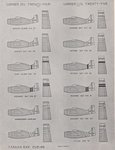Greetings,
I'm doing a profile illustration of my fiance's grandfather's Hellcat that he flew off
of the carrier Wasp late in the war.
I'm unable to locate any pictures of VF-86 hellcats thus far. These Hellcats have an X on the vertical stabilizer…and that's about all I know.
Any help appreciated.
Jim
I'm doing a profile illustration of my fiance's grandfather's Hellcat that he flew off
of the carrier Wasp late in the war.
I'm unable to locate any pictures of VF-86 hellcats thus far. These Hellcats have an X on the vertical stabilizer…and that's about all I know.
Any help appreciated.
Jim










